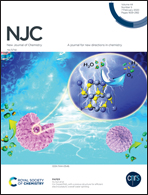Development of a DNA biosensor based on MCM41 modified screen-printed graphite electrode for the study of the short sequence of the p53 tumor suppressor gene in hybridization and its interaction with the flutamide drug using hemin as the electrochemical label†
Abstract
Electrochemical DNA biosensors are particularly attractive because of their high sensitivity, suitability and compatibility with miniaturization in nucleic acid technology. As a result, different kinds of biosensors can be developed to study different aspects of life sciences, such as diseases, mutagenesis, and the mechanism of interaction between ligands, drugs and molecules and DNA. In this study, an electrochemical biosensor was prepared by modifying a screen-printed graphite electrode with a mesoporous structure of MCM41 to immobilize the short sequence of the p53 tumor suppressor gene. The mesoporous structure introduces a significant surface area and can increase the amount of adsorbed DNA on the surface. The interaction of flutamide as an anticancer drug with ssDNA and dsDNA was studied in Tris–HCl buffer solution and also in the presence of Hemin (HEM) as a suitable electroactive redox label. The differential pulse voltammetry current of the HEM reduction peak decreases with increasing concentrations of Flu due to the interaction of DNA/Flu. The peak current of HEM linearly decreased with increasing concentration of Flu in the range of 0.7 to 10 μM (R2 = 0.99), with a detection limit of 0.1 μM.



 Please wait while we load your content...
Please wait while we load your content...